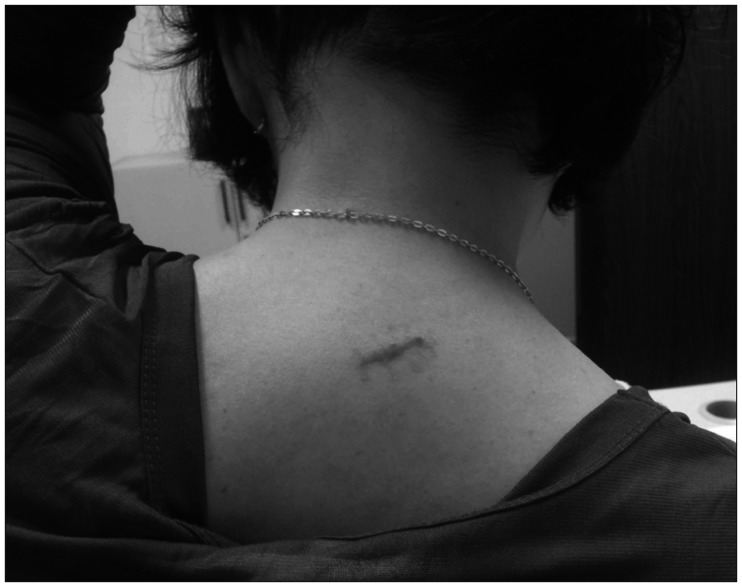Korean J Neurotrauma.
2015 Oct;11(2):180-182. 10.13004/kjnt.2015.11.2.180.
Brown-Sequard Syndrome after an Accidental Stab Injury of Cervical Spine: A Case Report
- Affiliations
-
- 1Department of Neurosurgery, Yeungnam University College of Medicine, Daegu, Korea. sw902@ynu.ac.kr
- KMID: 2378283
- DOI: http://doi.org/10.13004/kjnt.2015.11.2.180
Abstract
- We report a case of Brown-Sequard syndrome (BSS) caused by an accidental stab injury of the cervical spine that shows clear magnetic resonance imaging (MRI) findings and clinical presentation. A 42-year-old woman was brought into the emergency department after a stab injury on the right side of the posterior neck from a knife that was lying in a fruit basket after slipping. The patient complained of hemiparesis of the right-side extremities, and ipsilateral hypoesthesia and contralateral sensory loss of pain and temperature were also found on neurological examination. MRI showed a signal change of the C6-7 cord level and the tract of the stab wound through the posterior neck. Irrigation and primary closure of the laceration was performed under the impression of BSS. The neurologic deficit was improved with rehabilitation therapy.
MeSH Terms
Figure
Reference
-
1. Diabira S, Henaux PL, Riffaud L, Hamlat A, Brassier G, Morandi X. Brown-Sequard syndrome revealing intradural thoracic disc herniation. Eur Spine J. 2011; 20:65–70. PMID: 20589517.
Article2. Herr RD, Barrett J. An unusual presentation of Brown-Sequard syndrome. Ann Emerg Med. 1987; 16:1285–1288. PMID: 3662191.
Article3. Kamaoui I, Maaroufi M, Benzagmout M, Sqalli Houssaini N, Boujraf S, Tizniti S. MRI findings in spinal cord penetrating injury: three case reports. J Neuroradiol. 2007; 34:276–279. PMID: 17628679.4. Kobayashi N, Asamoto S, Doi H, Sugiyama H. Brown-Sèquard syndrome produced by cervical disc herniation: report of two cases and review of the literature. Spine J. 2003; 3:530–533. PMID: 14609700.
Article5. Kohno M, Takahashi H, Yamakawa K, Ide K, Segawa H. Postoperative prognosis of Brown-Séquard-type myelopathy in patients with cervical lesions. Surg Neurol. 1999; 51:241–246. PMID: 10086485.
Article6. Lee HM, Kim NH, Park CI. Spinal cord injury caused by a stab wound--a case report. Yonsei Med J. 1990; 31:280–284. PMID: 2281688.7. Lipschitz R, Block J. Stab wounds of the spinal cord. Lancet. 1962; 2:169–172. PMID: 14465744.
Article8. Mastronardi L, Ruggeri A. Cervical disc herniation producing Brown-Sequard syndrome: case report. Spine (Phila Pa 1976). 2004; 29:E28–E31. PMID: 14722422.9. McCarron MO, Flynn PA, Pang KA, Hawkins SA. Traumatic Brown-Séquard-plus syndrome. Arch Neurol. 2001; 58:1470–1472. PMID: 11559320.
Article10. McLean MM, Vert C, Dutcher M, Kollar R, Tilney PV. A 41-year-old man with an incomplete spinal cord injury. Air Med J. 2014; 33:6–9. PMID: 24373468.
Article11. O'Neill S, McKinstry CS, Maguire SM. Unusual stab injury of the spinal cord. Spinal Cord. 2004; 42:429–430. PMID: 15007377.12. Peacock WJ, Shrosbree RD, Key AG. A review of 450 stabwounds of the spinal cord. S Afr Med J. 1977; 51:961–964. PMID: 888030.13. Pollard ME, Apple DF. Factors associated with improved neurologic outcomes in patients with incomplete tetraplegia. Spine (Phila Pa 1976). 2003; 28:33–39. PMID: 12544952.
Article14. Ross ED, Kirkpatrick JB, Lastimosa AC. Position and vibration sensations: functions of the dorsal spinocerebellar tracts? Ann Neurol. 1979; 5:171–176. PMID: 426481.
Article15. Roth EJ, Park T, Pang T, Yarkony GM, Lee MY. Traumatic cervical Brown-Sequard and Brown-Sequard-plus syndromes: the spectrum of presentations and outcomes. Paraplegia. 1991; 29:582–589. PMID: 1787982.
Article16. Rubin G, Tallman D, Sagan L, Melgar M. An unusual stab wound of the cervical spinal cord: a case report. Spine (Phila Pa 1976). 2001; 26:444–447. PMID: 11224894.17. Simpson RK Jr, Venger BH, Narayan RK. Treatment of acute penetrating injuries of the spine: a retrospective analysis. J Trauma. 1989; 29:42–46. PMID: 2911102.
- Full Text Links
- Actions
-
Cited
- CITED
-
- Close
- Share
- Similar articles
-
- Brown-Sequard Syndrome due to Herniated Cervical Disc
- Brown Sequard Syndrome Resulting from Cervical Disc Herniation Treated by Anterior Foraminotomy
- Subclinical Cervical Osteochondroma Presenting as Brown-Sequard Syndrome after Trivial Neck Trauma
- A Brown-Sequard Syndrome Resulting from a Ruptured Cervical Disc Herniation: A Case Report
- Brown-Sequard Syndrome Caused by a Cervical Synovial Cyst



